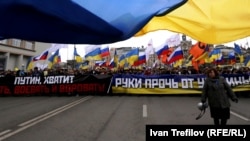For as long as Vladimir Putin has ruled Russia, his opponents have faced two foes: relentless, spiraling oppression by the state and the internal discord that often undermines their efforts to fight against a deeply entrenched adversary.
Ahead of what opposition leaders abroad hope will be a major demonstration in Berlin this weekend against Putin’s government and its war on Ukraine, controversy over a fundamental symbol -- the Russian flag -- has sparked discord.
The debate goes beyond bickering among the exiled opposition to Putin, playing into anger among many Ukrainians and some in the West who see the tricolor as an emblem of Russia’s unprovoked invasion of its neighbor and its aggression beyond its borders more broadly.
It comes as the opposition is struggling to maintain an influential voice after the unexplained jailhouse death of its most prominent leader, Aleksei Navalny, last February, and a decades-long clampdown that has escalated since the full-scale invasion of Ukraine and driven many of Putin’s critics out of Russia.
The dispute erupted after organizers of the November 17 march and rally in Berlin posted an announcement that featured an image from a protest in Moscow in 2014 against Russia’s takeover of Ukraine’s Crimean Peninsula. It showed a crowd of demonstrators, many holding the yellow-and-blue Ukrainian flag or the Russian tricolor, with its horizontal stripes of white, blue, and red.
For most, there was nothing controversial about that at the time. Ten years later, there certainly is -- and critics warned that demonstrators waving the Russian flag could undermine what co-organizer Ilya Yashin said was a main goal of the rallies planned in Berlin and other cities: to show that “a peaceful, free, and civilized Russia exists.”
“The Russian flag has long since become a symbol of aggression, war, and terror,” said Igor Eidman, a Russian emigrant and sociologist who lives in Germany and heads the German-Russian Human Rights Dialogue, an NGO.
He likened it to the swastika, saying that “the blood of innocent victims also drips from the Russian flag” and that its rightful place is “on the trash heap of history.”
Concerns about the signals sent by the Russian flag have given rise to an alternative: a flag of white, blue, and white with the removal of the red stripe, signaling opposition to the violence Moscow has unleashed and dismay at the bloodshed it has caused.
The white-blue-white flag emerged shortly after Russia launched the full-scale invasion of Ukraine on February 24, 2022, and has gained traction in the Russian opposition.
Eidman said he hopes that putting footage of the official Russian flag in announcements of the event was an innocent mistake and that demonstrators will not carry it, saying that Ukrainians in Germany are used to seeing it carried by “local Putinists who support the war.”
Ukrainians are not alone in taking issue with the tricolor. For some in the Russian opposition, their country’s flag is something to be avoided: a tainted symbol of Putin’s Russia, not the Russia they would like to live in.
“It’s the flag of the aggressor state,” political analyst Aleksandr Morozov wrote on Facebook on October 30.
Others, though, suggest that abandoning Russia’s official flag is tantamount to ceding it -- and by extension the country -- to Putin.
“The tricolor is just the same as the Kremlin, Catherine [the Great], or [Aleksandr] Pushkin: Putin has stolen them from us,” Konstantin Sonin, an economist who lives in the United States, wrote in a comment on Morozov’s post.
“I understand what ‘optics’ are and how this looks. But if the idea is, ‘Stop the war and return Russia to normalcy,’ then to march under other flags is like acknowledging Putin's right [to rule] Russia,” Sonin wrote, adding that he was unsure how best to resolve the issue.
As the controversy emerged late last month, Yashin, who was freed from a Russian prison in a major exchange with the West in August, said that “the discussion of flags clearly obscures the essence of the action that we want to hold in Berlin.”
The rally is “not about flags, but about solidarity with political prisoners, about rejection of aggressive war, and about resisting Putin’s policies,” he wrote on Facebook on October 31. “Let this action be a demonstration of the strength of the anti-war movement, a demonstration of the unity and potential of Russians who oppose the Putin regime.”
The other main organizers are Yulia Navalnaya, Navalny’s widow, and Vladimir Kara-Murza, who was released in the same prisoner swap as Yashin.
In comments on October 31, Kara-Murza said his view was that “people should be able to come [to the rally] with whatever flags they consider appropriate.” He stressed that “at this point we, as organizers, have no official position on the matter.”
That appeared to remain the case until a few days before the rally.
A November 14 post by Yashin on X urging people to attend made no reference to flags and included footage that briefly featured the Russian flag. At one point, it showed a solitary protester holding the tricolor and a sign that read: “I am a Russian. Putin is a murderer.”












